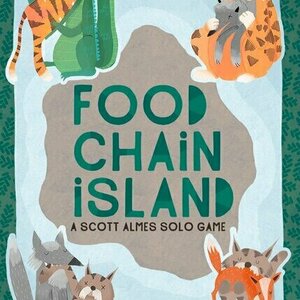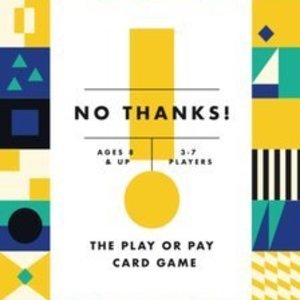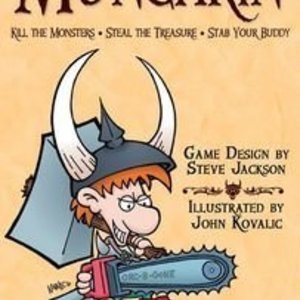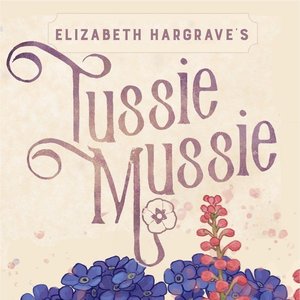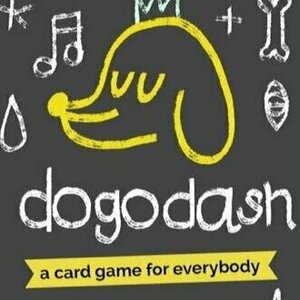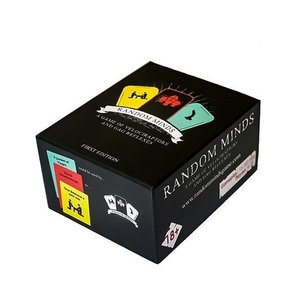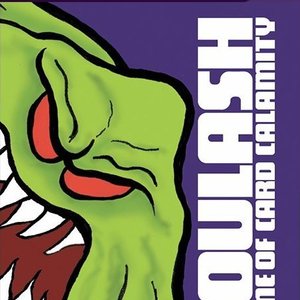Search
Search results
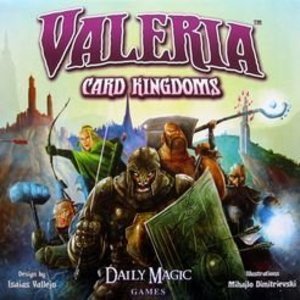
Valeria: Card Kingdoms
Tabletop Game
The land of Valeria is under siege by hordes of monsters. You and your fellow Dukes must recruit...
Purple Phoenix Games (2266 KP) rated Food Chain Island in Tabletop Games
Jul 1, 2020
With the current pandemic (not the game) going on in the world, and the necessity for people to distance themselves from each other, game nights everywhere have been put on hold. That doesn’t mean that gaming must stop! Whether you’re a seasoned solo gamer, or new to the solo genre, ButtonShy has done it again with a fantastic new little wallet game in their Simply Solo series – check it out!
You find yourself on a small, isolated island teeming with wildlife – but there is no set hierarchy! It’s a world of ‘eat or be eaten’ and you’ve got to survive. Manipulate the wildlife and organize the food chain in such a way that leaves you on top. Are you able to strategize the best meals, or will the island be left in chaos?
Disclaimer: We were provided a PnP version of Food Chain Island for the purposes of this preview. Please excuse my lack of a color printer, but rest assured that the artwork of the final product is eye-catching, colorful, and easy to read! Check out the Kickstarter (Live now through June 6th) for a look at the finished production copy. -L
Food Chain Island is a solo card game of network building and chaining in which players are trying to end with the fewest remaining cards possible. The game, like its other ButtonShy siblings, contains only 18 cards, divided into Land animals (16 cards) and Water animals (2 cards). All animals have a special power associated with it, and all of the Land animal cards are numbered from 0-15. To setup the game, set the 2 Water animals off to the side (you’ll use those later), shuffle all of the Land animals, and create a 4×4 face-up grid of Land animal cards. Now you can start the game!
Every turn you will move one animal card to ‘eat’ another. Select an animal, and move it one space in one of the four cardinal directions so that it is placed over top of another animal. The card that is now covered up is considered ‘eaten.’ Each animal may only eat certain other animals, however, so this is where the card number comes into play. An animal can only ‘eat’ any animal card that is 1-3 numbers lower than its value. For example, the ‘4’ animal can only eat cards 3, 2, or 1. Simple, right? Not so fast. Each animal also has a special ability on it, and you must activate the ability of that card once it has eaten another animal. This step is mandatory, and can really help or hinder your strategy – so make sure you are thinking about those abilities and not just the card numbers. At any time during the game, you may choose to discard one of the 2 Water animals from the side to perform its special ability in addition to, or instead of, the ability you just triggered. The game ends when you have only 1-3 animals remaining, the number remaining signifying varying degrees of success. If you have 4 or more animals remaining but are unable to make any more legal moves, the game is over and you have lost.
For being a game with such simple rules and gameplay, it is way more strategic than meets the eye. Each card can only eat specific cards, so you’re trying to position them in a way that fulfills those requirements numerically. You also have to be thinking ahead to each card power, because that step is mandatory. You cannot choose to ignore a card ability just because it may be detrimental to you – that’s what keeps your strategy changing at all times! You’re playing a long game here, and must be looking ahead several turns in advance so as to not accidentally strand yourself with no legal moves left. Every move should be thought through and carefully calculated to see if you can truly win the game. Along with that, every game will have a different starting grid which ensures that you won’t play the same game twice. The rules even suggest alternate beginning grid layouts to provide further challenge to players.
The other thing I love about Food Chain Island is that it is so fast to play, and it has a small footprint. If I only had 5 minutes to spare and was dying to play a game, Food Chain Island is what I would pull out. The speed of gameplay doesn’t take away from the engagement and thought needed to be successful, and that keeps me coming back for more. I rarely just play one game at a time – I will play 4-5 in a row because it is so addicting! Although it’s not officially a Tiny Epic game, it is designed by the one and only Scott Almes who hits it out of the park with this one as well. Coupled with the quick play time, the small footprint of the game makes it easy to play at any place or time you want.
With every new wallet game, ButtonShy continues to surprise me with quality gameplay and design using only 18 cards. Food Chain Island is no exception, and is a perfect first installation in their new Simply Solo line of wallet games. I know that this is a game I will be backing to get the final production copy in lieu of my PnP copy. I encourage everyone to check this game out – whether you’ve played solo games or not, this is a great little filler or introductory game to the genre. Visit the Kickstarter before it’s too late!
You find yourself on a small, isolated island teeming with wildlife – but there is no set hierarchy! It’s a world of ‘eat or be eaten’ and you’ve got to survive. Manipulate the wildlife and organize the food chain in such a way that leaves you on top. Are you able to strategize the best meals, or will the island be left in chaos?
Disclaimer: We were provided a PnP version of Food Chain Island for the purposes of this preview. Please excuse my lack of a color printer, but rest assured that the artwork of the final product is eye-catching, colorful, and easy to read! Check out the Kickstarter (Live now through June 6th) for a look at the finished production copy. -L
Food Chain Island is a solo card game of network building and chaining in which players are trying to end with the fewest remaining cards possible. The game, like its other ButtonShy siblings, contains only 18 cards, divided into Land animals (16 cards) and Water animals (2 cards). All animals have a special power associated with it, and all of the Land animal cards are numbered from 0-15. To setup the game, set the 2 Water animals off to the side (you’ll use those later), shuffle all of the Land animals, and create a 4×4 face-up grid of Land animal cards. Now you can start the game!
Every turn you will move one animal card to ‘eat’ another. Select an animal, and move it one space in one of the four cardinal directions so that it is placed over top of another animal. The card that is now covered up is considered ‘eaten.’ Each animal may only eat certain other animals, however, so this is where the card number comes into play. An animal can only ‘eat’ any animal card that is 1-3 numbers lower than its value. For example, the ‘4’ animal can only eat cards 3, 2, or 1. Simple, right? Not so fast. Each animal also has a special ability on it, and you must activate the ability of that card once it has eaten another animal. This step is mandatory, and can really help or hinder your strategy – so make sure you are thinking about those abilities and not just the card numbers. At any time during the game, you may choose to discard one of the 2 Water animals from the side to perform its special ability in addition to, or instead of, the ability you just triggered. The game ends when you have only 1-3 animals remaining, the number remaining signifying varying degrees of success. If you have 4 or more animals remaining but are unable to make any more legal moves, the game is over and you have lost.
For being a game with such simple rules and gameplay, it is way more strategic than meets the eye. Each card can only eat specific cards, so you’re trying to position them in a way that fulfills those requirements numerically. You also have to be thinking ahead to each card power, because that step is mandatory. You cannot choose to ignore a card ability just because it may be detrimental to you – that’s what keeps your strategy changing at all times! You’re playing a long game here, and must be looking ahead several turns in advance so as to not accidentally strand yourself with no legal moves left. Every move should be thought through and carefully calculated to see if you can truly win the game. Along with that, every game will have a different starting grid which ensures that you won’t play the same game twice. The rules even suggest alternate beginning grid layouts to provide further challenge to players.
The other thing I love about Food Chain Island is that it is so fast to play, and it has a small footprint. If I only had 5 minutes to spare and was dying to play a game, Food Chain Island is what I would pull out. The speed of gameplay doesn’t take away from the engagement and thought needed to be successful, and that keeps me coming back for more. I rarely just play one game at a time – I will play 4-5 in a row because it is so addicting! Although it’s not officially a Tiny Epic game, it is designed by the one and only Scott Almes who hits it out of the park with this one as well. Coupled with the quick play time, the small footprint of the game makes it easy to play at any place or time you want.
With every new wallet game, ButtonShy continues to surprise me with quality gameplay and design using only 18 cards. Food Chain Island is no exception, and is a perfect first installation in their new Simply Solo line of wallet games. I know that this is a game I will be backing to get the final production copy in lieu of my PnP copy. I encourage everyone to check this game out – whether you’ve played solo games or not, this is a great little filler or introductory game to the genre. Visit the Kickstarter before it’s too late!
Purple Phoenix Games (2266 KP) rated No Thanks! in Tabletop Games
Jan 6, 2020
Can a game with absolutely no theme be any good? Let’s find out with today’s game: No Thanks!
Usually in my intros I like throw a little flavor that matches the theme of the game. Well, I just couldn’t think of anything so you get the shortest intro I have done to date. No Thanks! is a great card game of push your luck. Period. I’ll tell you all the rules here since this mighty game may be bypassed in stores as it looks very unassuming and bland.
You are trying to get the least amount of points in a very nontraditional way. In the deck are cards numbered 3-35. You shuffle them all up and randomly eject from the game 9 cards. Nobody will know which 9. Why does that matter? Well, you score points (which is bad) equal to the lowest number of all your runs of cards. So a run of 3-4-5-6 scores 3 points because 3 is the lowest card. However, if 5 was one of the ejected cards and you had 3-4 and 6, you total would be 9 (3 from the first run and 6 from the next run since there wasn’t a 5 to connect them).
How do you get these cards? Well, on your turn you flip over a card from the face-down stack. Decide if you want to take that card into your tableau or if you would like to pass. If passing, you plop a red chip on it (of the 11 you were given at setup) and offer it to the next player. They can take the card along with the chip, or add a chip of their own. The offer now goes to the next player who does the same. Whomever ends up with the card also collects all the chips to be used on future cards.
This doesn’t really sound all that fun does it? Well it most certainly IS fun once you give it a go! Especially when you’re trying to decide if you should just take the 15 because you already have a run of 12-13-14 and it would be worth zero points, but you are also running low on chips. Let it ride around the table a couple times and get those chips! But beware of your opponents who will take the card out of spite and now you can’t connect your runs and you are low on chips. Uh oh Daddy-O!
This game is great with all player counts, and with all ages who can understand the math behind their choices. That’s why we at Purple Phoenix Games authorize a non-themed score of 8 / 12.
Usually in my intros I like throw a little flavor that matches the theme of the game. Well, I just couldn’t think of anything so you get the shortest intro I have done to date. No Thanks! is a great card game of push your luck. Period. I’ll tell you all the rules here since this mighty game may be bypassed in stores as it looks very unassuming and bland.
You are trying to get the least amount of points in a very nontraditional way. In the deck are cards numbered 3-35. You shuffle them all up and randomly eject from the game 9 cards. Nobody will know which 9. Why does that matter? Well, you score points (which is bad) equal to the lowest number of all your runs of cards. So a run of 3-4-5-6 scores 3 points because 3 is the lowest card. However, if 5 was one of the ejected cards and you had 3-4 and 6, you total would be 9 (3 from the first run and 6 from the next run since there wasn’t a 5 to connect them).
How do you get these cards? Well, on your turn you flip over a card from the face-down stack. Decide if you want to take that card into your tableau or if you would like to pass. If passing, you plop a red chip on it (of the 11 you were given at setup) and offer it to the next player. They can take the card along with the chip, or add a chip of their own. The offer now goes to the next player who does the same. Whomever ends up with the card also collects all the chips to be used on future cards.
This doesn’t really sound all that fun does it? Well it most certainly IS fun once you give it a go! Especially when you’re trying to decide if you should just take the 15 because you already have a run of 12-13-14 and it would be worth zero points, but you are also running low on chips. Let it ride around the table a couple times and get those chips! But beware of your opponents who will take the card out of spite and now you can’t connect your runs and you are low on chips. Uh oh Daddy-O!
This game is great with all player counts, and with all ages who can understand the math behind their choices. That’s why we at Purple Phoenix Games authorize a non-themed score of 8 / 12.
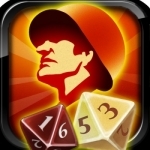
World Conqueror 1945
Games and Entertainment
App
World Conqueror 1945 is a new style strategy game on the background of WWⅡ(Super Risk). In the...
Griffin (480 KP) rated Munchkin in Tabletop Games
Dec 14, 2018
Has a lot of fun and silly cards. (1 more)
While the strategy is rather low, there are still some fun combos you can pull off to sabotage another player or ascertain victory for yourself.
Fun family game.
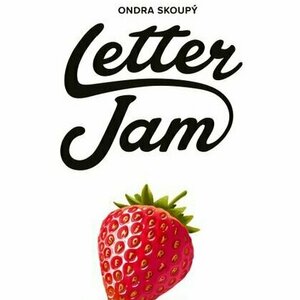
Letter Jam
Tabletop Game
Letter Jam is a 2-6 player cooperative word game where players assist each other in composing...
Purple Phoenix Games (2266 KP) rated Tussie Mussie in Tabletop Games
Jun 13, 2019
It is the Victorian Age. Music is getting better. Wardrobes are getting frillier. Friendships are getting… confusing. How do you tell your dear friend that they have upset you but you still very much care for them? By giving them a carefully crafted bouquet of flowers, with each bloom symbolizing a snippet of information you wish to relay. Thus is the story of Tussie-Mussies, the texting of the Victorian Age.
OK, I am not really a flower guy. My wife can attest to that. I like them. I think they are great outside in the landscaping. I just do not have an eye for combining them into intricate, meaningful bunches that really state my feelings. So when we received Tussie-Mussie from Button Shy Games, I was hopeful that I would not need to draw upon my severely-lacking knowledge of beautiful blossoms.
Thankfully, the game we received is a quick filler card game in Button Shy’s Wallet line, and it’s delightful. On your turn you will draw two cards from the deck and decide which you would like to offer to your neighbor face-up and which will be offered face-down (similar to the card assignments in Biblios). Your neighbor will then decide which card they will take, with the other card being returned to you for your collection. All players will offer cards to their neighbors and once the players each have four cards in front of them you may complete any card-driven actions. Once all players have had their chance to complete the printed actions the bouquets will be scored. Add your scores over three rounds of play to determine the winner of Tussie-Mussie.
Components. This is an 18-card micro-game that comes in the typical Button Shy Wallet. The wallet is fine and does what it sets out to do – protect the cards during transport. The cards themselves are of good quality, though I know not whether the quality of cards will be adjusted once the game completes its Kickstarter campaign upgrades through any planned stretch goals. The art is what really makes this game impressive. Beth Sobel knocks it out of the park again with the art here. The colors are vibrant, the flowers look amazing, and the layout is great. I have no complaints on components and art at all.
Is the game good? Yes! I think the game is very solid for what it is. I caution you not to go into this game with strategies devised and tactics you would like to try. This is not that kind of game. Since you never know the types of cards you will be receiving from your neighbors, your best strategy is trying to bluff and manipulate your neighbors into passing you the cards you really want. And isn’t that what the Victorian Age was really about, anyway? When you just cannot put together a winning collection of cards, just laugh it off and appreciate your gorgeous bouquet that you have assembled.
In the end, this game is really good for a quick light filler with amazing art that you will want to keep playing. The components are excellent, the game play is fun and light, and it helps to finish a game night or palette cleanse for the next game. Quite enjoyable! Here here!
OK, I am not really a flower guy. My wife can attest to that. I like them. I think they are great outside in the landscaping. I just do not have an eye for combining them into intricate, meaningful bunches that really state my feelings. So when we received Tussie-Mussie from Button Shy Games, I was hopeful that I would not need to draw upon my severely-lacking knowledge of beautiful blossoms.
Thankfully, the game we received is a quick filler card game in Button Shy’s Wallet line, and it’s delightful. On your turn you will draw two cards from the deck and decide which you would like to offer to your neighbor face-up and which will be offered face-down (similar to the card assignments in Biblios). Your neighbor will then decide which card they will take, with the other card being returned to you for your collection. All players will offer cards to their neighbors and once the players each have four cards in front of them you may complete any card-driven actions. Once all players have had their chance to complete the printed actions the bouquets will be scored. Add your scores over three rounds of play to determine the winner of Tussie-Mussie.
Components. This is an 18-card micro-game that comes in the typical Button Shy Wallet. The wallet is fine and does what it sets out to do – protect the cards during transport. The cards themselves are of good quality, though I know not whether the quality of cards will be adjusted once the game completes its Kickstarter campaign upgrades through any planned stretch goals. The art is what really makes this game impressive. Beth Sobel knocks it out of the park again with the art here. The colors are vibrant, the flowers look amazing, and the layout is great. I have no complaints on components and art at all.
Is the game good? Yes! I think the game is very solid for what it is. I caution you not to go into this game with strategies devised and tactics you would like to try. This is not that kind of game. Since you never know the types of cards you will be receiving from your neighbors, your best strategy is trying to bluff and manipulate your neighbors into passing you the cards you really want. And isn’t that what the Victorian Age was really about, anyway? When you just cannot put together a winning collection of cards, just laugh it off and appreciate your gorgeous bouquet that you have assembled.
In the end, this game is really good for a quick light filler with amazing art that you will want to keep playing. The components are excellent, the game play is fun and light, and it helps to finish a game night or palette cleanse for the next game. Quite enjoyable! Here here!
Purple Phoenix Games (2266 KP) rated Dogo Dash in Tabletop Games
Oct 15, 2020
During my youth, the best way to settle a disagreement was with a classic game of Rock, Paper, Scissors. As I got older, that translated to the card game War. What would happen if you mixed the two into one hybrid game? You’d get Dogo Dash!
Disclaimer: We were provided a PnP version of Dogo Dash for the purposes of this preview. The artwork and colors may see some changes between this preview and the final production, but is the most current version. -L
Dogo Dash is a trick-taking party game in which players are trying to earn points by collecting the most cards by the time the draw deck runs out. Setup is quick and easy – shuffle the deck and deal 4 cards to each player. Looking at their hands, players will then select one card to play this turn, and will place it face-down on the table. Once all players have chosen their card, everyone will reveal their cards at the same time. The player that played the strongest card is the winner for the turn, and collects all of the played cards. The strength of the cards is as follows: Cookie beats Bear and Dog, Bear beats Dog and Cat, Dog beats Cat, and Cat beats Cookie (and therefore all other cards this turn).
In the event of any ties, where multiple players have played the strongest card, play continues with a small change – the cards played in the round of the tie remain on the table. The tied players select another card from their hand and reveal it simultaneously. Whomever wins this tiebreaker collects all the cards. If the tiebreaker ends in another tie, then the tied players split the cards between themselves. If any player plays a Good Boy card, that round automatically is considered a tie, and a tiebreaker commences with all players. All players draw back up to 4 cards, and play continues in this fashion until the draw deck is empty. The player with the most cards at the end of the game is the winner!
As you can see, this game is pretty simple to learn and fast to play! The elements of War and Rock, Paper, Scissors are evident, but altered with more ‘character’ options and a more involved hierarchy of power. Unlike traditional Rock, Paper, Scissors, the animals/cards of Dogo Dash are more versatile in play. Instead of only beating one other type of card, each card will act differently based upon what other cards are played that turn. For example, Dog always beats Cat – unless someone also played Cookie. Because Cat beats Cookie, which beats Dog, so Cat wins this round! Instead of relying simply on numerical order to determine the hierarchy of power, the game feels more engaging and fun to play.
Another neat element is the inclusion of the Good Boy cards. When played, they automatically force a tie. All players then must participate in the tiebreaker. The Good Boy cards could be a strategic way to bag a ton of cards for yourself – forcing a tie and then winning the tiebreaker earns you essentially 2 rounds worth of cards! Or they could just be a silly way to interfere with opponents or just to keep a round from ending. There are also a couple of special card combos that can be played in a round, but I will leave those for you to discover on your own!
So all in all, how does Dogo Dash perform? I think it is a fast, fun, and light little game that can be played in many different situations. Whether you need a small filler game, are introducing newer gamers to the hobby, or want to find a game that is kid-friendly, Dogo Dash fits the bill. The gameplay feels familiar, but with a few twists, and that makes the overall game fun to play. Definitely check out Dogo Dash once it hits Kickstarter – you don’t want to miss out on this treat!
Disclaimer: We were provided a PnP version of Dogo Dash for the purposes of this preview. The artwork and colors may see some changes between this preview and the final production, but is the most current version. -L
Dogo Dash is a trick-taking party game in which players are trying to earn points by collecting the most cards by the time the draw deck runs out. Setup is quick and easy – shuffle the deck and deal 4 cards to each player. Looking at their hands, players will then select one card to play this turn, and will place it face-down on the table. Once all players have chosen their card, everyone will reveal their cards at the same time. The player that played the strongest card is the winner for the turn, and collects all of the played cards. The strength of the cards is as follows: Cookie beats Bear and Dog, Bear beats Dog and Cat, Dog beats Cat, and Cat beats Cookie (and therefore all other cards this turn).
In the event of any ties, where multiple players have played the strongest card, play continues with a small change – the cards played in the round of the tie remain on the table. The tied players select another card from their hand and reveal it simultaneously. Whomever wins this tiebreaker collects all the cards. If the tiebreaker ends in another tie, then the tied players split the cards between themselves. If any player plays a Good Boy card, that round automatically is considered a tie, and a tiebreaker commences with all players. All players draw back up to 4 cards, and play continues in this fashion until the draw deck is empty. The player with the most cards at the end of the game is the winner!
As you can see, this game is pretty simple to learn and fast to play! The elements of War and Rock, Paper, Scissors are evident, but altered with more ‘character’ options and a more involved hierarchy of power. Unlike traditional Rock, Paper, Scissors, the animals/cards of Dogo Dash are more versatile in play. Instead of only beating one other type of card, each card will act differently based upon what other cards are played that turn. For example, Dog always beats Cat – unless someone also played Cookie. Because Cat beats Cookie, which beats Dog, so Cat wins this round! Instead of relying simply on numerical order to determine the hierarchy of power, the game feels more engaging and fun to play.
Another neat element is the inclusion of the Good Boy cards. When played, they automatically force a tie. All players then must participate in the tiebreaker. The Good Boy cards could be a strategic way to bag a ton of cards for yourself – forcing a tie and then winning the tiebreaker earns you essentially 2 rounds worth of cards! Or they could just be a silly way to interfere with opponents or just to keep a round from ending. There are also a couple of special card combos that can be played in a round, but I will leave those for you to discover on your own!
So all in all, how does Dogo Dash perform? I think it is a fast, fun, and light little game that can be played in many different situations. Whether you need a small filler game, are introducing newer gamers to the hobby, or want to find a game that is kid-friendly, Dogo Dash fits the bill. The gameplay feels familiar, but with a few twists, and that makes the overall game fun to play. Definitely check out Dogo Dash once it hits Kickstarter – you don’t want to miss out on this treat!
Jodie Barker (70 KP) rated Random Minds in Tabletop Games
Dec 14, 2018
Multiple games to play (3 more)
Very funny and unique cards
As many players as you like
Fun party game
This is a very funny card game to play with friends/family who have a rude/silly sense of humour. You can play with as many people as you wish, and the more people you play with the more funny stories you make up. There are many different cards and different types of card (Action/Person/Object) so you can make a lot of unique combinations to make each other laugh. There are several different game modes you can try and even a drinking game.
I have only played a couple rounds of the normal game mode of this so far where one deck acts as your "base" cards and then you get 5 cards of each of the other decks. With your 10 cards you have to make a story including your base card from the pile you have selected. The base card is your starting point and can be anywhere within the story you create (beginning/middle/end). You can play as little or many cards as you like to make your story (10 Max) and the goal is to make your selected person laugh more than anyone else. Your selected person for that round chooses the winner out of everyone's stories and then they win the base card which acts as a point, and then you replace your used cards with new ones and the next person selected chooses the winner out of the next round. That is just one game mode and there are more that you can try out.
The only cons with this is that the instructions are not the clearest to understand, but once you figure it out and get used to it you can have plenty of fun with this game. And also even though there are decent sized decks to play with, if you have a few people playing you can go through the cards very quickly and then you could get the same cards over and over again, which isn't a problem but I hope the release new expansion packs in the future so you can get some new cards you haven't seen before.
** This is a very fun party game but it can also be offensive, rude and vulgar so it is best played with people of a certain kind of humour who will not get upset at the topics in this game.
I have only played a couple rounds of the normal game mode of this so far where one deck acts as your "base" cards and then you get 5 cards of each of the other decks. With your 10 cards you have to make a story including your base card from the pile you have selected. The base card is your starting point and can be anywhere within the story you create (beginning/middle/end). You can play as little or many cards as you like to make your story (10 Max) and the goal is to make your selected person laugh more than anyone else. Your selected person for that round chooses the winner out of everyone's stories and then they win the base card which acts as a point, and then you replace your used cards with new ones and the next person selected chooses the winner out of the next round. That is just one game mode and there are more that you can try out.
The only cons with this is that the instructions are not the clearest to understand, but once you figure it out and get used to it you can have plenty of fun with this game. And also even though there are decent sized decks to play with, if you have a few people playing you can go through the cards very quickly and then you could get the same cards over and over again, which isn't a problem but I hope the release new expansion packs in the future so you can get some new cards you haven't seen before.
** This is a very fun party game but it can also be offensive, rude and vulgar so it is best played with people of a certain kind of humour who will not get upset at the topics in this game.
Purple Phoenix Games (2266 KP) rated Ghoulash: The Game of Card Calamity in Tabletop Games
Sep 3, 2019
Ghoulash! I cannot say that word without using a Dracula-esque accent nor without my tummy grumbling (goulash is a yummy traditional Hungarian dish). Anyway, lunch time hangriness aside, Ghoulash is not a new game. In fact, the original version of Ghoulash was released in 2001 under Ghoulash Games. It is a pen-and-paper dungeon crawler for 2 players that we are reviewing as well. This game we are reviewing here is a card version prototype. So how does it play?
In Ghoulash: The Game of Card Calamity (which I will shorten to Ghoulash for the purpose of this review – even though there is the OG Ghoulash as well, I think you know what I’m talking about) players are Ghoul hunters. Ghouls are monstrous green blobsters that are coming for you. You fight them by shooting Ghoo, a purply substance, at them to exploit their weak spots and vanquish them. The first Ghoul hunter to reach 10 Victory Points (VPs) will be crowned the winner!
DISCLAIMER: We were provided a prototype copy of this game for the purposes of this review. As this is a preview copy of the game, I do not know if the final rules or components will be similar or different to what we were provided. -T
To setup the game, shuffle the deck and place a 6×3 grid of cards in the middle of the table. This is the “floor” and will be the game board for the duration of the game. When the floor is out of cards (I will explain), set out a new 6×3 grid floor and continue play. Deal each hunter a hand of seven cards and you are ready to play!
Each of the face down cards that comprise the floor are opportunities for encounters. You, as a Ghoul hunter, will enter the floor from any border card. On your turn you may fill your hand up to your current hand limit – which changes based on whether you have taken wounds or not. Next you must move orthogonally onto a space that contains a card or an empty space, but you must move – or take your Action first, THEN move. If you move to a space with a card, you encounter the card. Depending on what type of card is flipped face up you will be taking cards into your hand, following Command instructions, or fighting Ghouls. When you have finished your turn it is the next hunter’s turn.
Should your flipped card reveal an Action or Special card, you simply collect the card into your hand. If the flipped card is an Battle card (which has Ghoo splats – like the ones pictured above on the far right), you must follow the Command instructions at the bottom of the card before collecting to your hand. And if it’s a Ghoul you will begin battle!
Battling Ghouls is mechanically simple, but the overall battle may not be. When you face a Ghoul its card will tell you what the strength of the monster is (the white number). It could have four, five, or six hit points (HPs). To vanquish the Ghoul you will need to play cards whose Ghoo value (splats) is equal to or greater than the Ghoul’s HP amount. From this point the other hunters can intervene in the battle by playing cards whose battle Ghoo tips the scales toward the Ghoul thus making it more difficult to defeat (a la the ganging up mechanic in Munchkin). As only one hunter may affect the battle in this way, it is the player’s cards whose strength is greater that wins the challenge. Now the original combatant must spend more Ghoo cards to overcome the super-buffed Ghoul. Should the hunter prevail they will collect the Ghoul card and display it in front of them to show the table how many VPs they have earned. If the hunter is unsuccessful in the battle, they suffer wounds in the amount of VPs that would have been awarded with a successful battle (the green dots at the bottom of the card). Wounds are reflected by cards in hand, so if a hunter suffers two wounds, their hand limit is now five instead of the original seven. Play continues in this fashion until a hunter has accumulated 10 VPs and earned victory!
Components. Per my disclaimer, the game that was sent to us is a prototype version of the completed game, so components may (and probably will) change or be improved as a result of further development, and/or a successful Kickstarter campaign. That said, I can comment only on the components that were provided to us. The game is a deck of cards in a deck box. The cards themselves are of fine quality. The art upon them is okay. Nothing too stellar, but it gets the job done. I think the art is one thing that can be improved with development. Don’t get me wrong, the art is not at all bad. Perhaps it’s the card layout or graphic design. Something with a bit more punch would be appreciated.
Our thoughts on this one are that it needs some sprucing up a bit. Yes, it is in prototype format currently, and we know that. The card design needs to be updated a bit, but the game itself was also lacking a bit. One of the major concerns we had when playing through it was the card grid of the floor. We did not use any sort of player marker, token, meeple, or anything to mark our locations, and I really think that may have helped. We just had a hard time visualizing where our hunter was in relation to the face-down cards and how many turns it would take us to travel to them. There were several times where we just guessed as to who was actually closer and they were able to encounter the card. I am unsure how to fix that without supplying a grid or some sort of tracker. We should have maybe just played with meeples or dice for position markers. Oh heck I just thought of this: we could have also placed out dice or whatever on an x and y axis to denote where floor cards should be. Ugh. Battles were run somewhat smoothly, even though there were times where I was down to one card because I had suffered so many wounds and I could not get a First-Aid Kit to save my life (literally). The battle challenges did not work with us and we were trying to find a good way to make them happen, but our minds must not have been at their peak. We weren’t quite sure if, like in Munchkin, you could just add one card to your challenge total, or if you had to commit the entire bunch of cards you wish to play. It is not clear in the rules, so we went with our guts.
Overall, this could be a good dungeon crawler type card game. The theme is good, but for us it didn’t quite click…yet. If it sounds like something you would like to have in your collection, check Kickstarter for the campaign (if Ghoulash Games decides to crowd-fund this), contact the publisher directly, or (depending on date you read this) purchase from your FLGS. Oh, and keep the Ghoo Gone away – this time Ghoo is good for your health!
In Ghoulash: The Game of Card Calamity (which I will shorten to Ghoulash for the purpose of this review – even though there is the OG Ghoulash as well, I think you know what I’m talking about) players are Ghoul hunters. Ghouls are monstrous green blobsters that are coming for you. You fight them by shooting Ghoo, a purply substance, at them to exploit their weak spots and vanquish them. The first Ghoul hunter to reach 10 Victory Points (VPs) will be crowned the winner!
DISCLAIMER: We were provided a prototype copy of this game for the purposes of this review. As this is a preview copy of the game, I do not know if the final rules or components will be similar or different to what we were provided. -T
To setup the game, shuffle the deck and place a 6×3 grid of cards in the middle of the table. This is the “floor” and will be the game board for the duration of the game. When the floor is out of cards (I will explain), set out a new 6×3 grid floor and continue play. Deal each hunter a hand of seven cards and you are ready to play!
Each of the face down cards that comprise the floor are opportunities for encounters. You, as a Ghoul hunter, will enter the floor from any border card. On your turn you may fill your hand up to your current hand limit – which changes based on whether you have taken wounds or not. Next you must move orthogonally onto a space that contains a card or an empty space, but you must move – or take your Action first, THEN move. If you move to a space with a card, you encounter the card. Depending on what type of card is flipped face up you will be taking cards into your hand, following Command instructions, or fighting Ghouls. When you have finished your turn it is the next hunter’s turn.
Should your flipped card reveal an Action or Special card, you simply collect the card into your hand. If the flipped card is an Battle card (which has Ghoo splats – like the ones pictured above on the far right), you must follow the Command instructions at the bottom of the card before collecting to your hand. And if it’s a Ghoul you will begin battle!
Battling Ghouls is mechanically simple, but the overall battle may not be. When you face a Ghoul its card will tell you what the strength of the monster is (the white number). It could have four, five, or six hit points (HPs). To vanquish the Ghoul you will need to play cards whose Ghoo value (splats) is equal to or greater than the Ghoul’s HP amount. From this point the other hunters can intervene in the battle by playing cards whose battle Ghoo tips the scales toward the Ghoul thus making it more difficult to defeat (a la the ganging up mechanic in Munchkin). As only one hunter may affect the battle in this way, it is the player’s cards whose strength is greater that wins the challenge. Now the original combatant must spend more Ghoo cards to overcome the super-buffed Ghoul. Should the hunter prevail they will collect the Ghoul card and display it in front of them to show the table how many VPs they have earned. If the hunter is unsuccessful in the battle, they suffer wounds in the amount of VPs that would have been awarded with a successful battle (the green dots at the bottom of the card). Wounds are reflected by cards in hand, so if a hunter suffers two wounds, their hand limit is now five instead of the original seven. Play continues in this fashion until a hunter has accumulated 10 VPs and earned victory!
Components. Per my disclaimer, the game that was sent to us is a prototype version of the completed game, so components may (and probably will) change or be improved as a result of further development, and/or a successful Kickstarter campaign. That said, I can comment only on the components that were provided to us. The game is a deck of cards in a deck box. The cards themselves are of fine quality. The art upon them is okay. Nothing too stellar, but it gets the job done. I think the art is one thing that can be improved with development. Don’t get me wrong, the art is not at all bad. Perhaps it’s the card layout or graphic design. Something with a bit more punch would be appreciated.
Our thoughts on this one are that it needs some sprucing up a bit. Yes, it is in prototype format currently, and we know that. The card design needs to be updated a bit, but the game itself was also lacking a bit. One of the major concerns we had when playing through it was the card grid of the floor. We did not use any sort of player marker, token, meeple, or anything to mark our locations, and I really think that may have helped. We just had a hard time visualizing where our hunter was in relation to the face-down cards and how many turns it would take us to travel to them. There were several times where we just guessed as to who was actually closer and they were able to encounter the card. I am unsure how to fix that without supplying a grid or some sort of tracker. We should have maybe just played with meeples or dice for position markers. Oh heck I just thought of this: we could have also placed out dice or whatever on an x and y axis to denote where floor cards should be. Ugh. Battles were run somewhat smoothly, even though there were times where I was down to one card because I had suffered so many wounds and I could not get a First-Aid Kit to save my life (literally). The battle challenges did not work with us and we were trying to find a good way to make them happen, but our minds must not have been at their peak. We weren’t quite sure if, like in Munchkin, you could just add one card to your challenge total, or if you had to commit the entire bunch of cards you wish to play. It is not clear in the rules, so we went with our guts.
Overall, this could be a good dungeon crawler type card game. The theme is good, but for us it didn’t quite click…yet. If it sounds like something you would like to have in your collection, check Kickstarter for the campaign (if Ghoulash Games decides to crowd-fund this), contact the publisher directly, or (depending on date you read this) purchase from your FLGS. Oh, and keep the Ghoo Gone away – this time Ghoo is good for your health!
